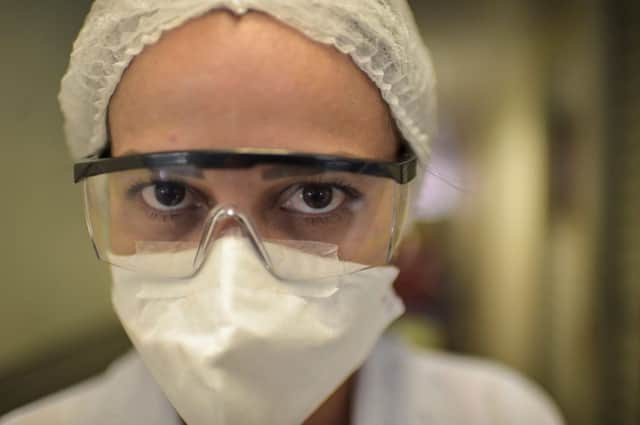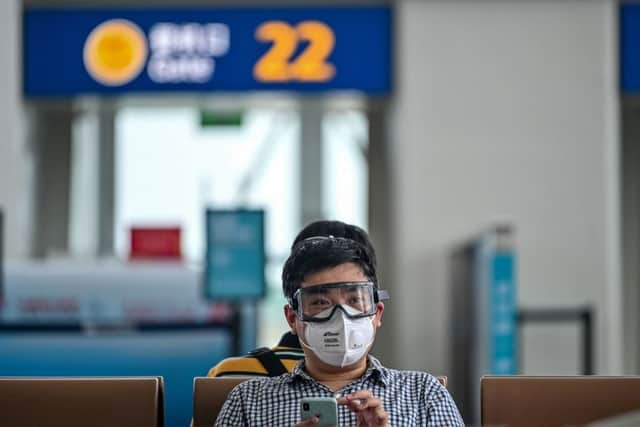Does wearing glasses or goggles protect you from coronavirus?


Researchers in China have found that people who wear glasses appear to be at lower risk of catching COVID-19.
The authors of the study, published in JAMA Ophthalmology, noticed that since the coronavirus outbreak in Wuhan in December 2019, few patients with spectacles were admitted to hospital suffering from COVID-19.
Advertisement
Hide AdAdvertisement
Hide AdTo investigate further, they collected data on the wearing of glasses from all patients with COVID-19 as part of their medical history.
Their small study found that only 16 (5.8%) of the 276 patients admitted with COVID-19 wore glasses for more than eight hours a day.
As they determined that all these patients were short-sighted, they next looked up the proportion of people with myopia (short-sightedness) in Hubei Province, where the hospital is located. They found this to be much larger (31.5%), indicating that the proportion of short-sighted COVID-19 hospital admissions was over five times lower than might be expected from that population.
This is a fascinating observation, but as with all single studies the results must be treated with caution. While eye protection has always been an important component of personal protective equipment (PPE), the magnitude of difference reported by this study raises suspicion.
Advertisement
Hide AdAdvertisement
Hide AdThis is not to say that the results may not be real, but rather that we shouldn’t start advising large-scale behavioural changes (such as wearing goggles alongside our face masks) until they have been independently confirmed.
Are eyes a window for the virus?
One of the key steps for any viral infection is the initial entry into the body. While most of our body is covered with protective skin, which is very effective at preventing viruses or bacteria crossing into our body, far thinner “membranes” cover our airways, digestive system and eyes.
The role of these thinner membranes is to allow external things such as oxygen, food, and in the case of eyes, light, into our bodies. Unfortunately, viruses have learned to take advantage of these entry points.
This is the reason PPE is designed to protect these entry points, through the use of face masks, goggles and protective clothing.


Advertisement
Hide AdAdvertisement
Hide AdHowever, whereas we might imagine that the main attack on these regions comes from viral particles transmitted through the air as aerosols, the main way that viral particles get to these weak points is actually via our hands. Hence the COVID-19 advice to wash our hands often, for 20 seconds or more, and avoid touching our faces.
It therefore makes sense that covering our eyes with glasses may offer extra protection, both from the virus that may be carried in other people’s breath, but also in preventing wearers from touching their eyes.
Indeed, as far back as February there were reports of people catching COVID-19 by not suitably protecting their eyes in healthcare settings. It is also known that similar points of entry into the body (ACE-2 receptors) favoured by the coronavirus are also present in the eyes.
Should we start wearing goggles?
A critical part of interpreting any evidence coming from observational studies is remembering that correlation (two things happening together) does not necessarily mean causation (one thing causes the other). To test for causation, a controlled trial or test is now needed.
Advertisement
Hide AdAdvertisement
Hide AdIdeally, this would follow two carefully matched groups of people – some wearing glasses and some not wearing glasses – to see which group gets infected more often. Evidence from such a controlled trial will always be far stronger than evidence from an observational study such as that in the recent paper.
We must also note that the authors of this study listed a number of weaknesses. It was a very small study at a single site. The researchers’ data for the general population came from a much earlier study on a sample that was not exactly matched (in terms of age, demography and other factors) to their sample admitted to hospital with COVID-19. And they couldn’t guarantee that all the people with short-sightedness in the general population also wore glasses for more than eight hours a day.
So although this new study is very interesting, there are plenty of reasons to be cautious about this result. We certainly need more data before any advice can be given about wearing goggles alongside our face masks.


By Simon Kolstoe, Senior Lecturer in Evidence Based Healthcare and University Ethics Advisor, University of Portsmouth
This article is republished from The Conversation under a Creative Commons license. Read the original article.